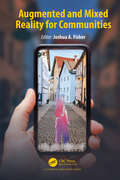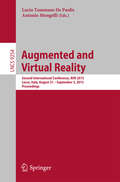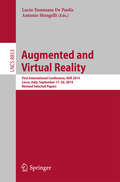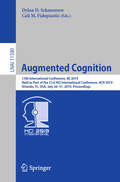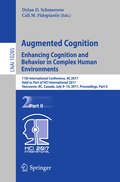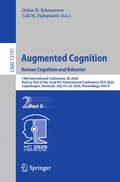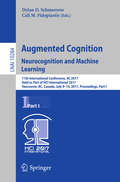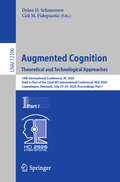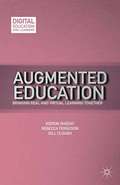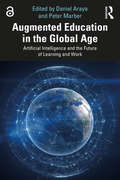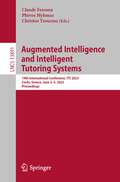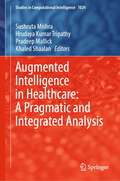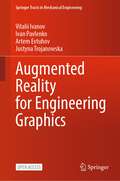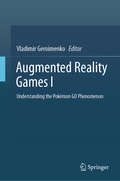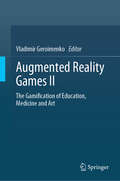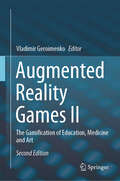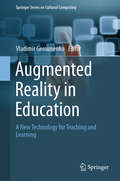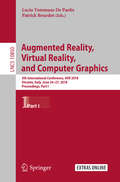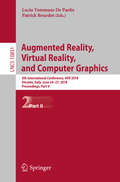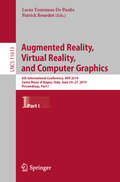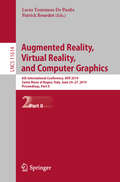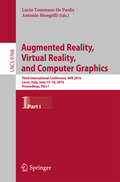- Table View
- List View
Augmented and Mixed Reality for Communities
by Joshua A. FisherUsing mixed and augmented reality in communities is an emerging media practice that is reshaping how we interact with our cities and neighbors. From the politics of city hall to crosswalks and playgrounds, mixed and augmented reality will offer a diverse range of new ways to interact with our communities. In 2016, apps for augmented reality politics began to appear in app stores. Similarly, the blockbuster success of Pokémon Go illustrated how even forgotten street corners can become a magical space for play. In 2019, a court case in Milwaukee, Wisconsin, extended first amendment rights to augmented reality. For all the good that these emerging media provide, there will and have been consequences. Augmented and Mixed Reality for Communities will help students and practitioners navigate the ethical design and development of these kinds of experiences to transform their cities. As one of the first books of its kind, each chapter in the book prepares readers to contribute to the Augmented City. By providing insight into how these emerging media work, the book seeks to democratize the augmented and mixed reality space.Authors within this volume represent some of the leading scholars and practitioners working in the augmented and mixed reality space for civic media, cultural heritage, civic games, ethical design, and social justice. Readers will find practical insights for the design and development to create their own compelling experiences. Teachers will find that the text provides in-depth, critical analyses for thought-provoking classroom discussions.
Augmented and Virtual Reality: Second International Conference, AVR 2015, Lecce, Italy, August 31 - September 3, 2015, Proceedings (Lecture Notes in Computer Science #9254)
by Lucio Tommaso De Paolis Antonio MongelliThis book constitutes the refereed proceedings of the Second International Conference on Augmented and Virtual Reality, AVR 2015, held in Lecce, Italy, in September 2015.The 32 papers and 8 short papers presented were carefully reviewed and selected from 82 submissions. The SALENTO AVR 2015 conference brings together a community of researchers from academia and industry, computer scientists, engineers, and physicians in order to share points of views, knowledge, experiences, and scientific and technical results related to state-of-the-art solutions and technologies on virtual and augmented reality applications for medicine, cultural heritage, education, industrial sectors, as well as the demonstration of advanced products and technologies.
Augmented and Virtual Reality: First International Conference, AVR 2014, Lecce, Italy, September 17-20, 2014, Revised Selected Papers (Lecture Notes in Computer Science #8853)
by Lucio Tommaso De Paolis Antonio MongelliThis book constitutes the thoroughly revised papers of the First International Conference on Augmented and Virtual Reality, AVR 2014, held in Lecce, Italy, in September 2014. The 28 papers, 2 tutorials and 3 keynotes presented were carefully reviewed and selected from 76 submissions. They include topics from virtual/augmented/mixed reality to 3D user interfaces and the technology needed to enable these environments to a wide range of applications (medical, entertainment, military, design, manufacture, maintenance, arts and cultural heritage).
Augmented Cognition: 13th International Conference, AC 2019, Held as Part of the 21st HCI International Conference, HCII 2019, Orlando, FL, USA, July 26–31, 2019, Proceedings (Lecture Notes in Computer Science #11580)
by Dylan D. Schmorrow Cali M. FidopiastisThis book constitutes the refereed proceedings of the 13th International Conference on Augmented Cognition, AC 2019, held as part of the 21st International Conference on Human-Computer Interaction, HCII 2019, in Orlando, FL, USA in July, 2019. The 1274 full papers and 209 posters presented at the HCII 2019 conferences were carefully reviewed and selected from 5029 submissions. The papers cover the entire field of human-computer interaction, addressing major advances in knowledge and effective use of computers in a variety of applications areas. The papers in this volume are organized in the following topical sections: cognitive modeling, perception, emotion and interaction; human cognition and behavior in complex tasks and environments; brain-computer interfaces and electroencephalography; and augmented learning.
Augmented Cognition. Enhancing Cognition and Behavior in Complex Human Environments: 11th International Conference, AC 2017, Held as Part of HCI International 2017, Vancouver, BC, Canada, July 9-14, 2017, Proceedings, Part II (Lecture Notes in Computer Science #10285)
by Dylan D. Schmorrow Cali M. FidopiastisThis volume constitutes the proceedings of the 11th International Conference on Augmented Cognition, AC 2017, held as part of the International Conference on Human-Computer Interaction, HCII 2017, which took place in Vancouver, BC, Canada, in July 2017. HCII 2017 received a total of 4340 submissions, of which 1228 papers were accepted for publication after a careful reviewing process. The papers thoroughly cover the entire field of Human-Computer Interaction, addressing major advances in knowledge and effective use of computers in a variety of application areas.The two volumes set of AC 2017 presents 81 papers which are organized in the following topical sections: electroencephalography and brain activity measurement, eye tracking in augmented cognition, physiological measuring and bio-sensing, machine learning in augmented cognition, cognitive load and performance, adaptive learning systems, brain-computer interfaces, human cognition and behavior in complex tasks and environments.
Augmented Cognition. Human Cognition and Behavior: 14th International Conference, AC 2020, Held as Part of the 22nd HCI International Conference, HCII 2020, Copenhagen, Denmark, July 19–24, 2020, Proceedings, Part II (Lecture Notes in Computer Science #12197)
by Dylan D. Schmorrow Cali M. FidopiastisThis book constitutes the refereed proceedings of 14th International Conference on Augmented Cognition, AC 2020, held as part of the 22nd International Conference on Human-Computer Interaction, HCII 2020, in July 2020. The conference was planned to be held in Copenhagen, Denmark, but had to change to a virtual conference mode due to the COVID-19 pandemic.From a total of 6326 submissions, a total of 1439 papers and 238 posters has been accepted for publication in the HCII 2020 proceedings. The 21 papers presented in this volume were organized in topical sections as follows: cognitive modeling, perception, emotion and interaction; electroencephalography and BCI; and AI and augmented cognition.
Augmented Cognition. Neurocognition and Machine Learning: 11th International Conference, AC 2017, Held as Part of HCI International 2017, Vancouver, BC, Canada, July 9-14, 2017, Proceedings, Part I (Lecture Notes in Computer Science #10284)
by Dylan D. Schmorrow Cali M. FidopiastisThis volume constitutes the proceedings of the 11th International Conference on Augmented Cognition, AC 2017, held as part of the International Conference on Human-Computer Interaction, HCII 2017, which took place in Vancouver, BC, Canada, in July 2017. HCII 2017 received a total of 4340 submissions, of which 1228 papers were accepted for publication after a careful reviewing process. The papers thoroughly cover the entire field of Human-Computer Interaction, addressing major advances in knowledge and effective use of computers in a variety of application areas.The two volumes set of AC 2017 presents 81 papers which are organized in the following topical sections: electroencephalography and brain activity measurement, eye tracking in augmented cognition, physiological measuring and bio-sensing, machine learning in augmented cognition, cognitive load and performance, adaptive learning systems, brain-computer interfaces, human cognition and behavior in complex tasks and environments.
Augmented Cognition. Theoretical and Technological Approaches: 14th International Conference, AC 2020, Held as Part of the 22nd HCI International Conference, HCII 2020, Copenhagen, Denmark, July 19–24, 2020, Proceedings, Part I (Lecture Notes in Computer Science #12196)
by Dylan D. Schmorrow Cali M. FidopiastisThis book constitutes the refereed proceedings of 14th International Conference on Augmented Cognition, AC 2020, held as part of the 22nd International Conference on Human-Computer Interaction, HCII 2020, in July 2020. The conference was planned to be held in Copenhagen, Denmark, but had to change to a virtual conference mode due to the COVID-19 pandemic.From a total of 6326 submissions, a total of 1439 papers and 238 posters has been accepted for publication in the HCII 2020 proceedings. The 21 papers presented in this volume were organized in topical sections as follows: cognitive modeling, perception, emotion and interaction; electroencephalography and BCI; and AI and augmented cognition.
Augmented Education: Bringing Real and Virtual Learning Together (Digital Education and Learning)
by K. Sheehy R. Ferguson G. CloughIncluding relevant case studies and interviews with practitioners, Augmented Education explores the nature of learning where the 'real world' is augmented by use of the virtual to create new learning possibilities, tools, and environments. and offers insights into the development of a pedagogy that is authentic, inclusive and enjoyable.
Augmented Education in the Global Age: Artificial Intelligence and the Future of Learning and Work
by Daniel Araya Peter MarberAugmented Education in the Global Age: Artificial Intelligence and the Future of Learning and Work is an edited collection that explores the social impact of Artificial Intelligence over the coming decades, specifically how this emerging technology will transform and disrupt our contemporary institutions. Chapters in this book discuss the history of technological revolutions and consider the anxieties and social challenges of lost occupations, as well as the evolution of new industries overlapping robotics, biotechnology, space exploration, and clean energy. Chapter authors unpack the nature of augmented education, from revamping curriculum and personalizing education, to redesigning workplace learning for an algorithmic era. Ultimately the book discusses policy and planning for an augmented future, arguing that work and learning are undergoing a metamorphosis around creativity and innovation amid a new global era and the race against automating technologies. Bringing together expert perspectives from around the world, this exciting, informative collection of research and analysis helps educators, policymakers and analysts navigate the future of work and learning amid rapid and accelerating technological change. The Open Access version of this book, available at http://www.taylorfrancis.com, has been made available under a Creative Commons Attribution-Non Commercial-No Derivatives (CC-BY-NC-ND) 4.0 license.
Augmented Education in the Global Age: Artificial Intelligence and the Future of Learning and Work
Augmented Education in the Global Age: Artificial Intelligence and the Future of Learning and Work is an edited collection that explores the social impact of Artificial Intelligence over the coming decades, specifically how this emerging technology will transform and disrupt our contemporary institutions. Chapters in this book discuss the history of technological revolutions and consider the anxieties and social challenges of lost occupations, as well as the evolution of new industries overlapping robotics, biotechnology, space exploration, and clean energy. Chapter authors unpack the nature of augmented education, from revamping curriculum and personalizing education, to redesigning workplace learning for an algorithmic era. Ultimately the book discusses policy and planning for an augmented future, arguing that work and learning are undergoing a metamorphosis around creativity and innovation amid a new global era and the race against automating technologies. Bringing together expert perspectives from around the world, this exciting, informative collection of research and analysis helps educators, policymakers and analysts navigate the future of work and learning amid rapid and accelerating technological change. The Open Access version of this book, available at http://www.taylorfrancis.com, has been made available under a Creative Commons Attribution-Non Commercial-No Derivatives (CC-BY-NC-ND) 4.0 license.
Augmented Intelligence and Intelligent Tutoring Systems: 19th International Conference, ITS 2023, Corfu, Greece, June 2–5, 2023, Proceedings (Lecture Notes in Computer Science #13891)
by Claude Frasson Phivos Mylonas Christos TroussasThis book constitutes the refereed proceedings of the 19th International Conference on Augmented Intelligence and Intelligent Tutoring Systems, ITS 2023, held in Corfu, Greece, during June 2-5, 2023. The 41 full papers and 19 short papers presented in this book were carefully reviewed and selected from 84 submissions. The papers are divided into the following topical sections: augmented intelligence in tutoring systems; augmented intelligence in healthcare informatics; augmented intelligence in games, serious games and virtual reality; neural networks and data mining; augmented intelligence and metaverse; security, privacy and ethics in augmented intelligence; and applied natural language processing.
Augmented Intelligence in Healthcare: A Pragmatic and Integrated Analysis (Studies in Computational Intelligence #1024)
by Sushruta Mishra Hrudaya Kumar Tripathy Pradeep Mallick Khaled ShaalanThe book discusses how augmented intelligence can increase the efficiency and speed of diagnosis in healthcare organizations. The concept of augmented intelligence can reflect the enhanced capabilities of human decision-making in clinical settings when augmented with computation systems and methods. It includes real-life case studies highlighting impact of augmented intelligence in health care. The book offers a guided tour of computational intelligence algorithms, architecture design, and applications of learning in healthcare challenges. It presents a variety of techniques designed to represent, enhance, and empower multi-disciplinary and multi-institutional machine learning research in healthcare informatics. It also presents specific applications of augmented intelligence in health care, and architectural models and frameworks-based augmented solutions.
Augmented Reality: Fundamentals and Applications
by Osslan Osiris Vergara Villegas Vianey Guadalupe Cruz SánchezThis book focuses on augmented reality (AR) technology, which uses the real environment to superimpose virtual elements. Therefore, the reader can create applications that simulate scenarios that can be dangerous or expensive to generate in the real world. AR has proven helpful in education, marketing, and industrial scenarios. AR technology improves the user experience of various disciplines, incorporating virtual information that maximizes the experience and adds knowledge. This book intends students, researchers, and developers to have the possibility of finding the foundations on which AR technology rests.Our book intends that students, researchers, and developers: (i) learn the basics of AR; (ii) understand the technologies that support AR; (iii) know about AR applications that have been a watershed; (iv) gain an understanding of the critical elements needed to implement an AR application; (v) acquire skill in the step-by-step development of an AR application; (vi) learn how to use the instruments to evaluate an AR application; (vii) understand how to present the information about study cases; and (viii) gain knowledge about AR challenges and trends.
Augmented Reality: Fundamentals and Applications
by Osslan Osiris Vergara Villegas Vianey Guadalupe Cruz SánchezThis book focuses on augmented reality (AR) technology, which uses the real environment to superimpose virtual elements. Therefore, the reader can create applications that simulate scenarios that can be dangerous or expensive to generate in the real world. AR has proven helpful in education, marketing, and industrial scenarios. AR technology improves the user experience of various disciplines, incorporating virtual information that maximizes the experience and adds knowledge. This book intends students, researchers, and developers to have the possibility of finding the foundations on which AR technology rests.Our book intends that students, researchers, and developers: (i) learn the basics of AR; (ii) understand the technologies that support AR; (iii) know about AR applications that have been a watershed; (iv) gain an understanding of the critical elements needed to implement an AR application; (v) acquire skill in the step-by-step development of an AR application; (vi) learn how to use the instruments to evaluate an AR application; (vii) understand how to present the information about study cases; and (viii) gain knowledge about AR challenges and trends.
Augmented Reality for Engineering Graphics (Springer Tracts in Mechanical Engineering)
by Vitalii Ivanov Ivan Pavlenko Artem Evtuhov Justyna TrojanowskaThis open access book offers a timely snapshot of Augmented Reality (AR) technology, with an emphasis on its application within the mechanical and manufacturing engineering domains, for both educational and industrial purposes. Reporting on the experience of the authors, the book introduces readers to the principles of product design, with an emphasis on modern strategies and approaches for user-centered design, creativity, and design for manufacturing and sustainability. It guides to the application augmented reality and visualization techniques in the design process. In turn, it describes an AR mobile application developed by the authors to transform 2D drawings into dynamic 3D objects. The book also includes exercises. All in all, this book offers a practice-oriented guide to Augmented Reality applications in mechanical engineering and education, addressing advanced undergraduate students, lecturers, and professionals in the engineering field. This is an open access book.
Augmented Reality Games I: Understanding the Pokémon GO Phenomenon
by Vladimir GeroimenkoThis is the first of two comprehensive volumes that provide a thorough and multi-faceted research into the emerging field of augmented reality games and consider a wide range of its major issues. These first ever research monographs on augmented reality games have been written by a team of 70 leading researchers, practitioners and artists from 20 countries. In Volume I, the phenomenon of the Pokémon GO game is analysed in theoretical, cultural and conceptual contexts, with emphasis on its nature and the educational use of the game in children and adolescents. Game transfer phenomena, motives for playing Pokémon GO, players’ experiences and memorable moments, social interaction, long-term engagement, health implications and many other issues raised by the Pokémon GO game are systematically examined and discussed. Augmented Reality Games I is essential reading not only for researchers, practitioners, game developers and artists, but also for students (graduates and undergraduates) and all those interested in the rapidly developing area of augmented reality games.
Augmented Reality Games II: The Gamification of Education, Medicine and Art
by Vladimir GeroimenkoThis is the second of two comprehensive volumes that provide a thorough and multi-faceted research into the emerging field of augmented reality games and consider a wide range of its major issues. These first ever research monographs on augmented reality games have been written by a team of 70 leading researchers, practitioners and artists from 20 countries. Volume II explores the most important and challenging issues that have been raised by the use of the Augmented Reality approach and technology in the gamification of education, healthcare, medicine and art. The volume deals with a systematic analysis of educational augmented reality games, their use for health promotion in old age and for improving people’s well-being, the gamification of augmented reality art and immersive reading experiences, among other topics. Augmented Reality Games II is essential reading not only for researchers, practitioners, game developers and artists, but also for students (graduates and undergraduates) and all those interested in the rapidly developing area of augmented reality games.
Augmented Reality Games II: The Gamification of Education, Medicine and Art
by Vladimir GeroimenkoThis is the second edition of the first ever research monograph that explores the exciting field of augmented reality games and their enabling technologies. The new edition has been thoroughly revised and updated, with 6 new chapters included. As well as investigating augmented reality games in education, the book covers the gamification of medicine, healthcare, and art. It has been written by a team of 43 researchers, practitioners, and artists from 12 countries, pioneering in developing and researching the new type of computer games.This book deals with a systematic analysis of educational augmented reality games, the gamification of elementary and secondary education, teachers’ novel key skills and new teaching methods in the classroom, creating immersive and playful reading experiences, augmented reality games for health promotion in old age and for transforming dental and physical education and practice, the gamification of augmented reality art, pervasive games, and gaming in public spaces, among other topics.Intended as a starting point for exploring this new fascinating area of research and game development, it will be essential reading not only for researchers, practitioners, game developers, and artists, but also for students (graduates and undergraduates) and all those interested in the rapidly developing area of augmented reality games.
Augmented Reality in Education: A New Technology for Teaching and Learning (Springer Series on Cultural Computing)
by Vladimir GeroimenkoThis is the first comprehensive research monograph devoted to the use of augmented reality in education. It is written by a team of 58 world-leading researchers, practitioners and artists from 15 countries, pioneering in employing augmented reality as a new teaching and learning technology and tool. The authors explore the state of the art in educational augmented reality and its usage in a large variety of particular areas, such as medical education and training, English language education, chemistry learning, environmental and special education, dental training, mining engineering teaching, historical and fine art education. Augmented Reality in Education: A New Technology for Teaching and Learning is essential reading not only for educators of all types and levels, educational researchers and technology developers, but also for students (both graduates and undergraduates) and anyone who is interested in the educational use of emerging augmented reality technology.
Augmented Reality, Virtual Reality, and Computer Graphics: 5th International Conference, AVR 2018, Otranto, Italy, June 24–27, 2018, Proceedings, Part I (Lecture Notes in Computer Science #10850)
by Lucio Tommaso De Paolis Patrick BourdotThe 2-volume set LNCS 10850 and 10851 constitutes the refereed proceedings of the 5th International Conference on Augmented Reality, Virtual Reality, and Computer Graphics, AVR 2018, held in Otranto, Italy, in June 2018. The 67 full papers and 26 short papers presented were carefully reviewed and selected from numerous submissions. The papers are organized in the following topical sections: virtual reality; augmented and mixed reality; computer graphics; human-computer interaction; applications of VR/AR in medicine; and applications of VR/AR in cultural heritage; and applications of VR/AR in industry.
Augmented Reality, Virtual Reality, and Computer Graphics: 5th International Conference, AVR 2018, Otranto, Italy, June 24–27, 2018, Proceedings, Part II (Lecture Notes in Computer Science #10851)
by Lucio Tommaso De Paolis Patrick BourdotThe 2-volume set LNCS 10850 and 10851 constitutes the refereed proceedings of the 5th International Conference on Augmented Reality, Virtual Reality, and Computer Graphics, AVR 2018, held in Otranto, Italy, in June 2018. The 67 full papers and 26 short papers presented were carefully reviewed and selected from numerous submissions. The papers are organized in the following topical sections: virtual reality; augmented and mixed reality; computer graphics; human-computer interaction; applications of VR/AR in medicine; and applications of VR/AR in cultural heritage; and applications of VR/AR in industry.
Augmented Reality, Virtual Reality, and Computer Graphics: 6th International Conference, AVR 2019, Santa Maria al Bagno, Italy, June 24–27, 2019, Proceedings, Part I (Lecture Notes in Computer Science #11613)
by Lucio Tommaso De Paolis Patrick BourdotThe 2-volume set LNCS 11613 and 11614 constitutes the refereed proceedings of the 6th International Conference on Augmented Reality, Virtual Reality, and Computer Graphics, AVR 2019, held in Santa Maria al Bagno, Italy, in June 2019.The 32 full papers and 35 short papers presented were carefully reviewed and selected from numerous submissions. The papers discuss key issues, approaches, ideas, open problems, innovative applications and trends in virtual and augmented reality, 3D visualization and computer graphics in the areas of medicine, cultural heritage, arts, education, entertainment, military and industrial applications. They are organized in the following topical sections: virtual reality; medicine; augmented reality; cultural heritage; education; and industry.
Augmented Reality, Virtual Reality, and Computer Graphics: 6th International Conference, AVR 2019, Santa Maria al Bagno, Italy, June 24–27, 2019, Proceedings, Part II (Lecture Notes in Computer Science #11614)
by Lucio Tommaso De Paolis Patrick BourdotThe 2-volume set LNCS 11613 and 11614 constitutes the refereed proceedings of the 6th International Conference on Augmented Reality, Virtual Reality, and Computer Graphics, AVR 2019, held in Santa Maria al Bagno, Italy, in June 2019.The 32 full papers and 35 short papers presented were carefully reviewed and selected from numerous submissions. The papers discuss key issues, approaches, ideas, open problems, innovative applications and trends in virtual and augmented reality, 3D visualization and computer graphics in the areas of medicine, cultural heritage, arts, education, entertainment, military and industrial applications. They are organized in the following topical sections: virtual reality; medicine; augmented reality; cultural heritage; education; and industry.
Augmented Reality, Virtual Reality, and Computer Graphics: Third International Conference, AVR 2016, Lecce, Italy, June 15-18, 2016. Proceedings, Part I (Lecture Notes in Computer Science #9768)
by Lucio Tommaso De Paolis Antonio MongelliThe 2-volume set LNCS 9768 and 9769 constitutes the refereed proceedings of the Third International Conference on Augmented Reality, Virtual Reality and Computer Graphics, AVR 2016, held in Lecce, Italy, in June 2016.The 40 full papers and 29 short papers presented werde carefully reviewed and selected from 131 submissions. The SALENTO AVR 2016 conference intended to bring together researchers, scientists, and practitioners to discuss key issues, approaches, ideas, open problems, innovative applications and trends on virtual and augmented reality, 3D visualization and computer graphics in the areas of medicine, cultural heritage, arts, education, entertainment, industrial andmilitary sectors.
